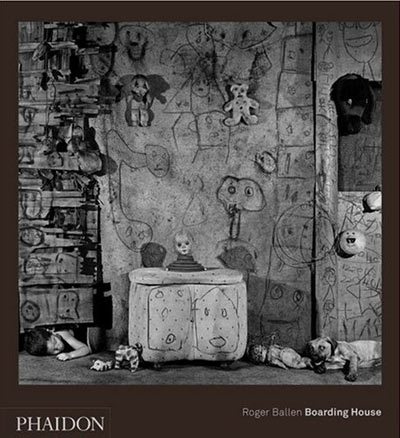Review: Boarding House by Roger Ballen
 Roger Ballen’s work is often deemed to be disturbing. I don’t think is actually is (my idea of “disturbing” might be different from yours), but we can probably easily agree on calling him one of the most creative photographers currently producing work. Boarding House
Roger Ballen’s work is often deemed to be disturbing. I don’t think is actually is (my idea of “disturbing” might be different from yours), but we can probably easily agree on calling him one of the most creative photographers currently producing work. Boarding House contains his most recent images, and it shows the photographer following the directions laid out in his earlier Shadow Chamber
.
Boarding House contains images of puppies, kittens, and people (plus an assortment of other animals, some cuddly, others not), but, of course, such a simple description would be extremely misleading in many different ways. Nevertheless, it’s instructive to note that there are various puppies or kittens in Ballen’s work, because to a certain extent our discourse on photography (what it can do, should do, or should not do) has become a bit kabuki-esque, with conventions telling us what can be done and what can’t. Puppies and kittens, so it is deemed, belong into the realm of Cute Overload, but not into the kinds of dystopias presented in Ballen’s work. Maybe that is what makes it so disturbing for many people: The refusal to play the games that everybody else is playing.
Another frequent reaction to these photos is people wondering whether the photographer might have in fact staged something, or altered what he found. While staging has become a more or less widely accepted practice, Ballen’s use of black and white in these photographs might still have crossed a threshold since b/w is a (if not the) holdout of photographic orthodoxy. But so what if the photographer changed something? Who cares? I don’t even want to know to what extent Ballen was involved in changing what he found in people’s homes, because that would be taking away from experiencing the work! It’s like looking at an abstract painting and then wondering whether the painter used a spatula or a brush for some areas. There is a reason why those kinds of discussions simply don’t happen in most art forms. If photography really wants to be taken seriously as an art form, it’s time to stop having them here, too!
Ballen’s work is becoming more and more similar to painting. Another way to think about it would be view it as photographs of unmoving performance art. But regardless of how you view it, what is clear is that there has been a very creative and somewhat unusual mind at work, a mind willing to look at places - mental or physical - that many people shy away from. Crucially, we need to be able to not let our thinking of how to approach photography (which has yet to catch up with how this art form has already changed) get in the way of experiencing this work.
Some of the photographs reminded me a little bit of Joel-Peter Witkin’s work, except that here, Witkin’s overly obvious goriness has been replaced with something more subtle. And it needs to be added, once you start reading the images they reveal a lot more than a first, superficial glance would make it seem. You will have to come back to Boarding House many times to have the images fully reveal themselves.
All of this makes Boarding House a clear must-buy for anyone collecting photography books. Needless to say, this being a Phaidon book, it’s wonderfully produced. Boarding House
shows contemporary photography at its finest.